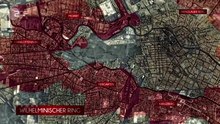Wilhelmine ring
The Wilhelminischer Ring is the name of the tenement barracks that was built around the old city center of Berlin in the second half of the 19th century . It is characterized by a dense development with four to five-storey residential buildings with side wings and rear buildings. The name is reminiscent of the time this development was built under the regents Wilhelm I and Wilhelm II.
location
The Wilhelminischer Ring contains large parts of the Berlin districts Wedding , Gesundbrunnen , Prenzlauer Berg , Friedrichshain , Kreuzberg , Neukölln , Schöneberg , Tiergarten , Moabit and Charlottenburg . It essentially covers the area between the demolished in the 1860s Akzisemauer and the S-Bahn ring , but is partly also beyond this.
Formation requirements and characteristics
The increasing industrialization in the Wilhelminian era led to a considerable demand for labor, which was met by the strong influx of people to Berlin, also as a result of the great rural exodus. For this additional workforce, living space was required in the immediate vicinity of the factories, for which space in the old city limits was no longer available.
In 1861, the area of Berlin had been expanded by 70 percent to 5923 hectares due to large-scale incorporations ; according to the census of the year, 547,571 people lived in the city . In the next 30 years, the population of Berlin should almost triple, while the area of the city only increased insignificantly. The planning requirements for the necessary residential construction were created in 1862 by James Hobrecht with the development plan for the surroundings of Berlin, which is mostly named after him today . As the name of the plan suggests, this went far beyond the boundaries of the recently enlarged city, but only established a grid of ring and radial streets with relatively large block sizes, thus favoring the rapid emergence of large tenements.
The decisive factor, however, was the building police ordinance issued in 1853, which, apart from compliance with street alignment and a minimum size of the inner courtyards of 5.34 m × 5.34 m, the turning circle of the fire engines at the time , hardly imposed any regulations on the building owners . So built private builders under high ground advantage in the following decades the area of Wilhelmine ring with the typical 5 to 6-storey dwellings, which, as the builders of the width of the frontage to the road development costs were involved, mostly relatively narrow front homes, but several Owned side wings and rear buildings. In line with Hobrecht's ideas, there were often larger apartments for middle-class families in the front buildings , which were particularly well furnished with stucco and parquet in the “ Bel Etage ” . The rear buildings were narrow, badly ventilated, mostly only offered shared or courtyard toilets, and were mostly inhabited by working class families. In the areas of the Wilhelminischer Ring the population density was over 1000 inhabitants per hectare. Over 20 percent of the workers in 1880 were so-called " sleeper boys ", that is, they had no apartment, but only a place to sleep in an overcrowded apartment - even without them.
Only the new building regulations issued in 1887 imposed stricter rules on the building owners. For example, the eaves height was limited to 22 meters and the number of storeys to five.
Current situation
Today, the Wilhelminischer Ring is characterized by a high density of buildings and the lack of open spaces and green areas , unless it was significantly destroyed in the Second World War . The population density is still very high today with over 550 inhabitants per hectare . However, in the course of the urban redevelopment, the backyards were gutted in many places, i.e. the number of rear buildings was reduced, and the number of apartments, especially in the rear buildings, was reduced by merging.
- The Wilhelminischer Ring clockwise
The Kurfürstenstraße forms the border between the Tiergarten and Schöneberg








